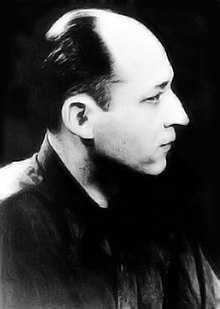Benjamin Péret
Benjamin Péret | |
|---|---|
 | |
| Born | 4 July 1899 Rezé, Loire-Atlantique, France |
| Died | 18 September 1959 (aged 60) Paris, Île-de-France, France |
| Nationality | French |
| Known for | Writing |
| Movement | Dada, Surrealism |
| French and Francophone literature |
|---|
| by category |
| History |
| Movements |
| Writers |
| Countries and regions |
| Portals |
Benjamin Péret (4 July 1899 – 18 September 1959) was a French poet, Parisian Dadaist and a founder and central member of the French Surrealist movement[1][2] with his avid use of Surrealist automatism.
Biography
Benjamin Péret was born in Rezé, France on 4 July 1899.[3] He, as a child, acquired little education due to his dislike of school and he instead attended the Local Art School from 1912. He too, however, resigned soon after in 1913 due to his sheer lack of study and willingness to do so. Afterwards he spent a short period of time in a School of Industrial Design before enlisting in the French army's Cuirassiers during the First World War to avoid being jailed for defacing a local statue with paint. He saw action in the Balkans before being deployed to Salonica, Greece.
During a routine movement of his unit via train, he discovered a copy of the magazine Sic, sitting upon a bench on the station platform, which contained poetry by Apollinaire – sparking his love for poetry. Towards the end of the war, still in Greece, he suffered from an attack of Dysentery which led to his repatriation and deployment in Lorraine for the remainder of the war.[4]
After the end of the war he joined the Dada movement and soon after, in 1921, he published Le Passager du transtlantique – his first book of poetry before he abandoned the Dada movement to follow André Breton and the emerging Surrealist movement, working alongside and influencing the Mexican writer Octavio Paz.
In the fall of 1924 he was the co-editor of the journal La Révolution surréaliste, becoming chief editor in 1925. And in 1928, before immigrating to Brazil in 1929 with his wife Elsie Houston, he published Le Grand Jeu. Two years later in 1931, a mere few months after the birth of his first son, Geyser, whilst living in Rio de Janeiro, he was arrested and expelled from Brazil on grounds of being a 'Communist Agitator' – having formed, with his brother-in-law Mario Pedrosa, the Brazilian Communist League which was based upon the ideas of Trotsky.[5]
Having returned to France and buffeted by the winds of politics, he fought for the Republicans in the Spanish Civil War. In 1940 he was imprisoned for his political activities. Upon his release he sailed for Mexico with the aid of the American-based Emergency Rescue Committee to study pre-Columbian myths and American Folklore. He had originally wished to emigrate to the United States but was unable to do so due to his Communist affiliations. Peret went to Mexico with his lover, the Spanish painter Remedios Varo. In Mexico City he became involved with the European intellectual community around the Austrian painter and surrealist Wolfgang Paalen living there in exile. He was particularly inspired by Paalen´s huge collection and knowledge about the "Totem Art" of the Northwestcoast of British Columbia; 1943 he finished a long essay on the necessity of poetical myths, exemplified with the mythology and art of the Northwestcoast, which was then published in New York by André Breton in VVV.[6] Whilst living in Mexico City Peret met Nathalia Sedova, Trotsky's widow.
He remained in Mexico until the end of 1947. He returned to Paris and died there on 18 September 1959.
Works
1921: Le Passager du transatlantique
1925: Cent cinquante-deux proverbes mis au goût du jour, en collaboration avec Paul Éluard
1927: Dormir, dormir dans les pierres
1928: Le Grand Jeu
1934: De derrière les fagots
1936: Je sublime
1936: Je ne mange pas de ce pain-là
1945: Le Déshonneur des poètes
1945: Dernier Malheur dernière chance
1946: Un point c’est tout
1952: Air mexicain
1955: Le Livre de Chilam Balam de Chumayel
1956: Anthologie de l’amour sublime
1957: Gigot, sa vie, son œuvre
1960: Anthologie des mythes, légendes et contes populaires d’Amérique
References
- ^ Surrealist Writers. Alangullette.com. Retrieved on 20 September 2011.
- ^ Atlas Press Trade Titles – Death To The Pigs – Benjamin Péret. Atlaspress.co.uk. Retrieved on 20 September 2011.
- ^ Benjamin Peret | artist and art. The-artists.org (18 September 1959). Retrieved on 20 September 2011.
- ^ [1][dead link]
- ^ Claude Courtot : Benjamin Péret (1899–1959). Benjamin-peret.org. Retrieved on 20 September 2011.
- ^ Benjamin Péret: La parole est à Péret, New York 1943, also in: Œuvres complètes, Tome 6, Les Amériques et autres lieux, Paris 1992, p. 18ff
Further reading
Death to the Pigs and the Field of Battle. Atlas Press, 1988.
Mad Balls. Atlas Press, 1991.
The Automatic Muse. Atlas Press, 1994.
From the Hidden Storehouse (Selected Poems by Benjamin Peret). Oberlin College, 1991.
A Menagerie in Revolt! Selected Writings. Black Swan Press, 2009.
Four Years After the Dog. Poems of Benjamin Peret. Arc Publications, 1974.
Irregular Work. Peret. Actual Size Press, 1984.
